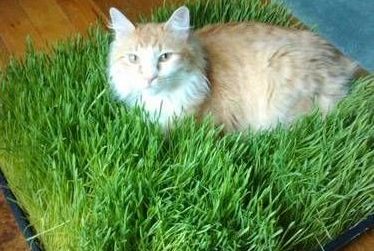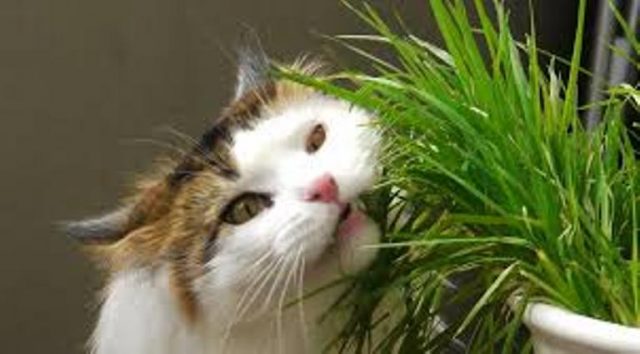It is quite typical for members of the feline population to nibble on grass and if your kitty is an outdoor cat, chances are that it snacks on grasses on a daily basis. However, if your fur buddy is the type that spends all of its time indoors, then, it is your responsibility to grow some pots of indoor cat grass for its benefit. For this write-up, we are poised to explain the meaning of cat grass, how it is grown, and its benefits to your cat.
Table of Contents
What Is Cat Grass?
Catnip belongs to the mint family; thus, it shouldn’t be confused with cat grass. Typically, cat grass is grown from wheat, barley, rye, or oats. There are cat grass kits available at local pet stores in your vicinity; these kits are equipped with apparatus ranging from seeds, pot, and soil. It is now your responsibility to ensure the provision of sunlight and water, and within a few days, your furbaby will be enjoying its own cat grass garden – organic and healthy.
It is possible that outdoor grasses may have been chemically treated with things like pesticides, so indoor grass is safer. With indoor cat grass, your furball will have a healthy and safe alternative to eating flowers and household plants, which may turn out to be toxic. Always seek the counsel of your veterinarian before introducing any plants or flowers into your home.
How Do I Grow Cat Grass?
There are several steps to take for growing cat grass, and you need to gather a few things like
- A suitable container (window box can suffice)
- Plastic wrap
- Organic soil (sterilized)
- Planting seeds for cat grass
- Water
The essence of using organic soil is to ensure that both the grass and soil are healthy for the cat to dig into. Fertilizer is not a necessity; the grass is not expected to live beyond a few weeks.
Planting
For the planting of your indoor cat grass, fill the container with about 2 inches depth of soil before scattering a few seeds on it. Cover the seeds with a little dirt (a thin layer like ¼ inch) and allow them to germinate.
Germination And Growth
You can use your hand to spill some water on the soil; a sprayer can also be used to moisten the soil effectively; however, this has to be done gently to avoid dispersing the seed. A plastic wrap is used to cover the container once you are satisfied that the soil has enough water. The planting pot should be placed in some dark and cool corner of the house after perforating the plastic wrap to give room for airflow – this is to ensure that the seeds germinate.
Tiny sprouts will start emerging within a couple of days or three if the soil is constantly moistened. Now, the container goes to your desired spot after the plastic wrap has been dispensed with. Your best bet is to position the pot where it will be possible for it to receive rays of sunlight or indirect light. The grass shouldn’t be allowed to grow higher than four to six inches in height. Recommendations are that you always reduce it to the specified height; failure to do so may make your canine friend uproot all the grass, destroying the cat grass garden in the process.
Some Seeds That Can Be Used For Growing Cat Grass
Cat grass can be grown from several seeds like oat, wheat, and rye, barley – all of these can be cultivated and managed indoors.
Oat Grass
Oat grass is healthy, a bit sweet, and has the best taste among every other cat grass, including wheatgrass. Direct sunlight is required for the grass to thrive.
Wheat Grass
Wheatgrass is not just good for the human diet, the vitamins, minerals, and amino acid content of wheatgrass is quite beneficial for the feline population.
Rye Grass
Relative to other varieties of cat grass, ryegrass comes with smaller blades. Ideal for creating a lounging place for the cat in the form of a grassy tray.
Barley Grass
This grass is replete with essential minerals, vitamins, enzymes, and amino acids – these nutrients are readily taken into the bloodstream.
Some Tips You Should Know
- Prior to sprouting, keep the seeds damp but not soaked. Less water should be used with the appearance of the sprouts.
- Up to seven days should be allowed for the seed to sprout.
- After it has sprouted, another 10 to 14 days will have to elapse before your cat can eat the grass.
- Always allow the plant to have access to natural light and be sure to water it daily.
- Overwatering can lead to mold.
- The cat should be allowed to eat from the pot directly.
- A new container should be planted after the grass has outlived its life span (changed color or wilted)
Is Cat Grass Safe For Cats?
Cat grass is a safe alternative to outdoor grass which can be treated with weed killers or other pesticides. It provides your cat with an opportunity to engage in its natural behavior. For outdoor cats, an indoor garden provides a healthy alternative to nibbling on the neighbor’s possibly pesticide-laced lawn. For indoor cats, it offers a delicious taste of the outdoors.
Read Also: Do Dogs Have Down Syndrome?
Reasons Your Cat Needs Cat Grass

Though research is yet to establish this, experts have proffered ideas on the reason felines nibble on grass.
Cats ingest a lot of grasses in the wild after consuming their prey. In several cases, the cats vomit after taking grass, and the experts believe that it is the feline’s natural way of expelling the indigestible part of the prey.
Even a cat that has never lynched a whole prey will still be attracted to grass instinctively. The reason here is that it is one of the behavioral instincts of felines. Grass functions as fiber, aiding the kitty in either digesting hairball or vomiting same as a laxative.
There is a theory that says that grass is a source of vitamins A and D, including some trace minerals. The chlorophyll content of grass was used as a remedy for infection, pain, skin disease, ulcers, and anemia – all these were before antibiotics were discovered.
Part of the components of grass is folic acid which aids hemoglobin production – that protein that assists a cat’s circulation by moving oxygen into their blood.
In conclusion, cat grass is a healthy addition to a cat’s diet, so always make it available for your cat to benefit from.
